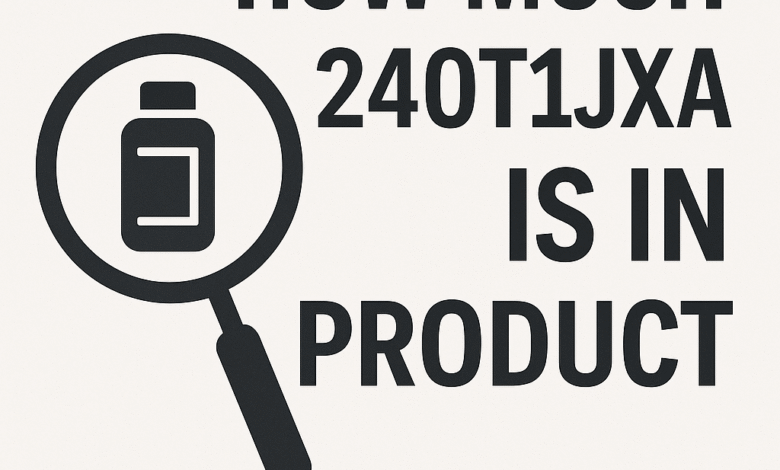
Exploring the Identity, Significance, and Presence of 24ot1jxa in Consumer Goods
In a world filled with high-tech innovations, chemical additives, and cryptic product codes, new terms frequently emerge, often puzzling both consumers and professionals. One such mysterious code—“24ot1jxa”—has been appearing in discussions related to products, digital systems, and even cybersecurity. Among the most intriguing queries surrounding this term is the question: “How much 24ot1jxa is in product?”
This article aims to fully unpack this query by examining what 24ot1jxa might be, its potential applications, and how its concentration or usage could vary depending on context. Whether it’s a chemical compound, a digital signature, or a cybersecurity anomaly, we will explore each angle in detail.
What Is “24ot1jxa”?
Before discussing how much of it is in a product, we must understand what 24ot1jxa actually is. Based on emerging reports and expert interpretations, 24ot1jxa can fall into three main categories:
1. A Unique Alphanumeric Identifier
In the tech world, “24ot1jxa” appears to be a pseudo-random string often used as a:
- Session token
- Product SKU (Stock Keeping Unit)
- Version number or batch code
- API key or internal tracking code
Such identifiers are not substances but rather reference tags embedded in digital systems or printed on physical products. For instance, a cosmetic product may include a batch number like 24ot1jxa to identify manufacturing origin or packaging date.
In this context, asking “how much 24ot1jxa is in a product” would be misleading—because it’s not a measurable material, just a label.
2. A Cybersecurity Artifact
Another interpretation views “24ot1jxa” as a suspicious code or malware tag identified in cybersecurity systems. Some reports suggest it’s associated with:
- Keyloggers or backdoor entries
- Trojan payloads
- Data exfiltration threats
- Hidden scripts in infected software
In this case, the question becomes more about whether a product (e.g., software or hardware) contains 24ot1jxa as a security vulnerability, rather than how much of it is present.
Here, the “how much” is metaphorical—referring to the extent of contamination or infection in a digital system.
3. A Synthetic Chemical Compound
A third and perhaps the most concrete interpretation is that 24ot1jxa is a synthetic compound used in certain industries. Some researchers describe it as a:
- Surfactant or polymer additive
- Coating agent in electronics
- Binding agent in cosmetics
- Flame retardant in plastics or textiles
In this context, the question “how much 24ot1jxa is in a product?” becomes highly relevant, because it involves actual quantifiable presence in a given formulation—be it by weight, volume, or concentration level.
How Much 24ot1jxa Is Typically Found in Products?
If we treat 24ot1jxa as a chemical ingredient, then understanding its usage concentration across industries becomes essential. Below is a breakdown of how much 24ot1jxa might be found in various product categories.
🔹 1. Household Cleaning Products
In cleaning agents like detergents, disinfectants, or multi-surface sprays, 24ot1jxa might function as:
- A surfactant enhancer
- A fragrance stabilizer
- A color preservative
Typical concentration:
- 1.2% to 3.5% by volume
These levels are well within consumer safety guidelines but are often regulated under product labeling laws, depending on region.
🔹 2. Personal Care and Cosmetics
Used for texturizing or prolonging shelf life in:
- Lotions
- Shampoos
- Deodorants
- Serums
Typical concentration:
- 0.5% to 2.8% by weight
Because of its potential for skin absorption, its use is strictly monitored by cosmetic regulatory bodies like the FDA (U.S.) or ECHA (EU).
🔹 3. Electronics and Circuit Boards
Here, 24ot1jxa might serve as:
- A conformal coating
- An insulating resin
- A chemical stabilizer for heat resistance
Typical concentration:
- 350 to 1200 ppm (parts per million)
This ensures the integrity of electrical components under thermal stress or electromagnetic interference.
🔹 4. Automotive Products
Additives in:
- Engine cleaners
- Lubricants
- Dashboard polishes
Typical concentration:
- 0.8% to 4.2% by volume
Automotive-grade versions may require higher chemical thresholds due to harsh environmental exposures (e.g., high heat or pressure).
🔹 5. Food-Related Materials
In food packaging, coatings, or processing equipment, 24ot1jxa may exist as a non-food contact surface additive (like Teflon or phthalate variants).
Typical concentration:
- 5 mg to 120 mg per package or serving unit
Such use is often indirect and must comply with food safety standards like those from FDA or EFSA.
How Is the Quantity of 24ot1jxa Measured?
To determine how much 24ot1jxa is in a product, manufacturers use a variety of analytical and labeling methods:
✔ Mass Spectrometry (MS)
Used for ultra-trace detection of 24ot1jxa in samples as small as nanograms.
✔ Gas Chromatography (GC)
Especially effective when 24ot1jxa is volatile or part of complex mixtures like oils and fragrances.
✔ Label Disclosure
According to safety regulations, the amount of substances like 24ot1jxa (if considered hazardous or bioactive) must be listed:
- On Material Safety Data Sheets (MSDS)
- On product ingredient panels
Is 24ot1jxa Safe?
This depends on concentration and the nature of exposure:
⚠ Potential Health Risks
If inhaled, ingested, or absorbed through the skin in high doses, synthetic compounds like 24ot1jxa may:
- Irritate mucous membranes
- Disrupt endocrine systems
- Bioaccumulate in fatty tissues
✅ Regulation & Compliance
To protect consumers, various agencies enforce limits on 24ot1jxa’s use:
- OSHA for workplace exposure
- FDA for cosmetics or packaging
- EPA for environmental release
- REACH (EU) for chemical substances in products
Always check if the product you’re buying includes “compliant levels” of such ingredients.
What If “24ot1jxa” Is a Cybersecurity Threat?
If the context is digital—e.g., 24ot1jxa is found in a software product or website—the question changes.
Questions You Should Ask:
- Is 24ot1jxa a malware hash or identifier?
- What product contains it—an app, a browser extension, a plugin?
- What is the infection vector or payload?
In this case, “how much” could mean:
- Extent of infected files
- Degree of data leakage or system breach
- Number of endpoints affected
You may need to:
- Run malware scans
- Review network traffic
- Contact the product vendor or cybersecurity team
How to Find Out If a Product Contains 24ot1jxa
- Read the Label or Packaging
Look for batch numbers, ingredient lists, or digital codes. - Check the Product’s MSDS or Ingredient Database
Search for 24ot1jxa by chemical name, CAS number, or variant label. - Contact Manufacturer Support
Request technical specifications or clarification about the role and quantity of 24ot1jxa. - Use Digital Forensics (for Software)
Install tools like:
- Wireshark
- Malwarebytes
- CrowdStrike Falcon
These may detect if 24ot1jxa is present in code or system logs.
Final Thoughts: A Multifaceted Mystery
The phrase “how much 24ot1jxa is in product” is deceptively simple but opens up a host of technical, chemical, and cybersecurity questions. Understanding what 24ot1jxa refers to is crucial before you can measure “how much” of it exists.
- ✅ If it’s a chemical, concentration matters for health and safety.
- 🔐 If it’s a digital token, it’s about identification—not quantity.
- ⚠ If it’s a malware marker, it’s a red flag requiring swift action.
In a world increasingly defined by synthetic materials and digital interconnectivity, staying informed about seemingly cryptic identifiers like 24ot1jxa is essential for consumers, developers, and regulators alike.https://blogvista.co.uk/



